Experimental and Analytical Study on the Axial Behavior of Circular High-Strength Concrete Columns with Hybrid Carbon Fibers and Steel Confinement System
Abstract
:1. Introduction
2. Dual Confinement Model
3. Experimental Program
3.1. Material Properties
3.1.1. Concrete
3.1.2. Reinforcing Steel
3.1.3. Carbon-Fiber Mesh (CFM)
3.2. The Hybrid Confinement System
4. Test Setup
4.1. Testing Machine
4.2. Measurements
5. Results and Discussion
5.1. Failure Mode
5.2. Load–Displacement Curves
| 1 | 2 | 3 | 4 | 5 | 6 | 7 | 8 | 9 | 10 | 11 | 12 | |
|---|---|---|---|---|---|---|---|---|---|---|---|---|
| Experimental Results | Model Prediction | |||||||||||
| Specimen | Pmax (kN) | Peak Axial Disp. (mm) | Peak Axial Strain | Spalling Lateral Concrete Strain | Peak Stress {1}(MPa) | Peak Strain {1} | Model Peak Stress (MPa) | Error (%) | Model Strain at Peak Stress | Error (%) | ||
| 1 | S80C0a | 4367 | 1.24 | 1.33 | 0.00219 | 0.000576 | 126.0 | 0.00459 | 107.1 | −15.0 | 0.00485 | 5.7 |
| 2 | S80C0b | 4407 | 1.25 | 1.82 | 0.00300 | 0.000334 | 118.0 | 0.00503 | 107.1 | −9.2 | 0.00485 | −3.6 |
| 3 | S80C0c | 4106 | 1.16 | 1.23 | 0.00203 | 0.000596 | 113.0 | 0.00357 | 107.1 | −5.2 | 0.00485 | 36.0 |
| 4 | S130C1a | 3695 | 1.05 | 1.04 | 0.00171 | 0.000875 | 100.0 | 0.00269 | 96.7 | −3.3 | 0.00343 | 27.1 |
| 5 | S130C1b | 3537 | 1.00 | 1.08 | 0.00178 | 0.000399 | 106.8 | 0.00400 | 96.7 | −9.5 | 0.00343 | −14.4 |
| 6 | S130C2a | 3509 | 0.99 | 1.15 | 0.00161 | 0.000406 | 98.8 | 0.00212 | 98.0 | −0.8 | 0.00358 | 68.2 |
| 7 | S130C2b | 3794 | 1.07 | 1.54 | 0.00230 | 0.000559 | 105.0 | 0.00318 | 98.0 | −6.6 | 0.00358 | 12.5 |
| 8 | S130C4a | 3801 | 1.08 | 1.01 | 0.00166 | 0.000519 | 109.0 | 0.00259 | 102.7 | −5.8 | 0.00420 | 62.1 |
| 9 | S130C4b | 3239 | 0.92 | 0.89 | 0.00147 | 0.000341 | 95.0 | 0.00265 | 102.7 | 8.1 | 0.00420 | 58.3 |
| 10 | S130C4c | 3410 | 0.97 | 0.74 | 0.00122 | 0.000174 | 107.6 | 0.00244 | 102.7 | −4.6 | 0.00420 | 72.4 |
| 11 | S180C3a | 3197 | 0.91 | 1.56 | 0.00256 | 0.000357 | 99.0 | 0.00349 | 97.5 | −1.5 | 0.00363 | 4.0 |
| 12 | S180C3b | 2937 | 0.83 | 1.52 | 0.00250 | 0.000232 | 92.0 | 0.00468 | 97.5 | 5.9 | 0.00363 | −22.5 |
| Mean percentage error (%) | −4.0 | 25.5 | ||||||||||
| Mean absolute percentage error (MAPE) (%) | 6.3 | 32.2 | ||||||||||
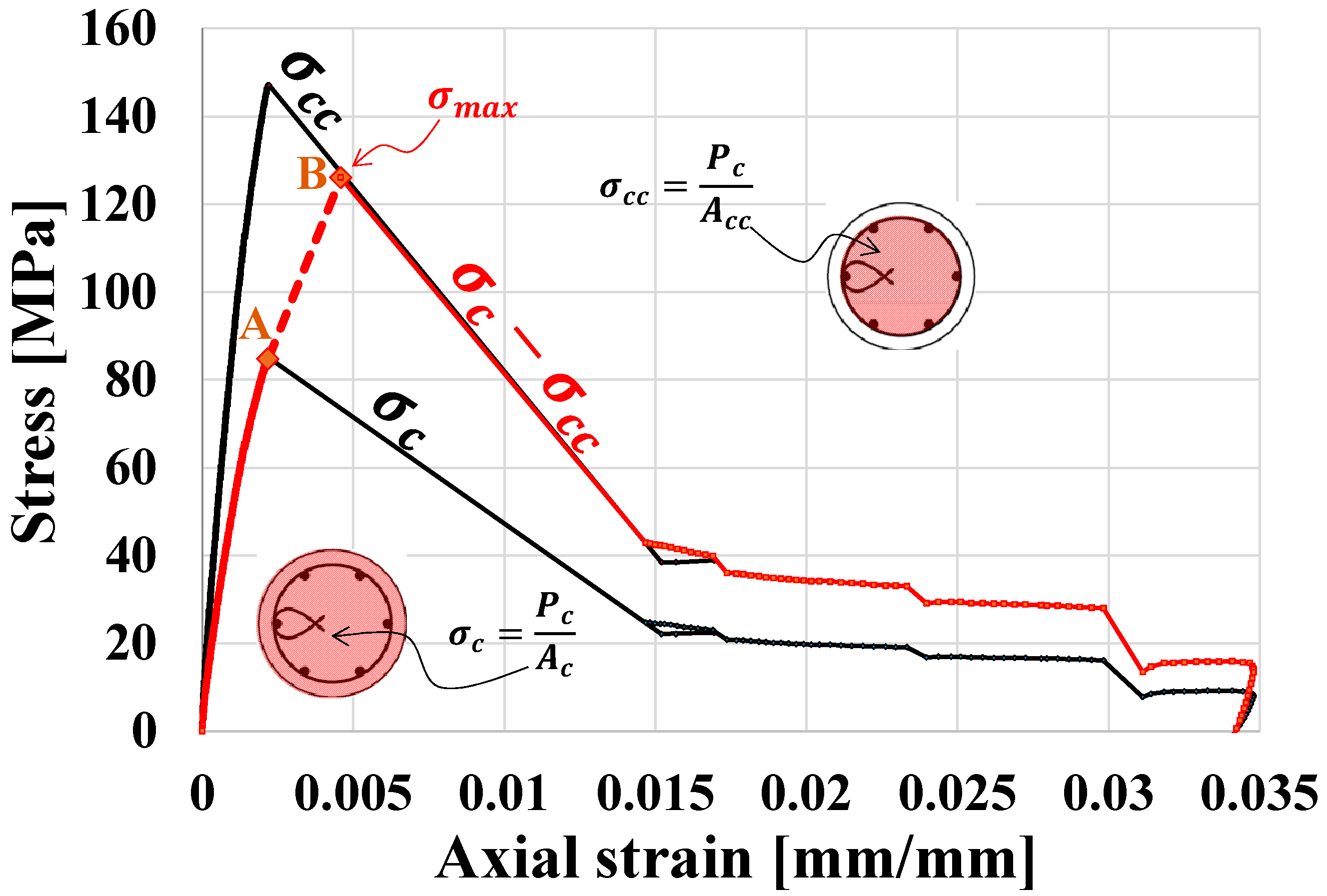
6. Analysis of Test Results
6.1. Columns’ Stress–Strain Relation
6.2. Stress–Strain Results
6.3. Ductility Assessment
6.4. Model Validation
6.5. Influence of CFM Confinement
7. Conclusions
- For a given amount of conventional transverse steel, the application of carbon-fiber meshes gives efficiency to the rebar confinement, in terms of both the load bearing capacity and the ductility.
- For the specimens with the hybrid confinement system, the higher the amount of carbon fibers the larger the ductility improvement.
- Yet, for the confinement transverse reinforcement and CFM amounts tested in this study, the hybrid system was less efficient in terms of ductility compared to the conventional reinforcement. It is noted though, that the control specimens had a relatively high conventional volumetric lateral reinforcement ratio (of 1.78%) that was greater than that of the hybrid specimens.
- Fair to good agreement was observed between the model and the measured stress–strain curves, especially of the peak stresses.
- There was an improvement in the column’s ductility with increasing CFM thickness, where this improvement was more pronounced for lower amounts of steel confinement.
Author Contributions
Funding
Data Availability Statement
Acknowledgments
Conflicts of Interest
References
- ACI. ACI Report on Equivalent Rectangular Concrete Stress Block and Transverse Reinforcement for High-Strength Concrete Columns (441.1R-18); American Concrete Institute: Farmington Hills, MI, USA, 2018. [Google Scholar]
- Lee, H.-J.; Lai, Y.-L.; Chen, C.-W.; Tao, C.-C.; Lee, H. Behavior and modeling of high-strength concrete tied columns under axial compression. J. Chin. Inst. Eng. 2018, 41, 353–365. [Google Scholar] [CrossRef]
- Shah, S.P.; Zia, P.; Johnston, D. Economic Considerations for Using High Strength Concrete in High Rise Buildings. 1983; a study prepared for Elborg technology Co. [Google Scholar]
- Luther, M.D.; Bauer, K.C. Using High Strength Concrete Simplifies Precast Column Design. Concr. Constr. 1987, 32, 546–547. [Google Scholar]
- Schmidt, W.; Hoffman, E.S. 9000 psi concrete—Why? Why not? Civ. Eng. 1975, 45, 52–55. [Google Scholar]
- Zia, P.; Leming, M.L.; Ahmad, S.H. High-Performance Concretes: A State-Of-The-Art Report; North Carolina State University: Raleigh, NC, USA, 1991. [Google Scholar]
- Kunze, W.E. High-strength Concrete in the United States. In Proceedings of XIV Biennial Conference in Concrete; Concrete Institute of Australia: Sydney, Australia, 1995. [Google Scholar]
- Antonius; Imran, I.; Setiyawan, P. On the Confined High-strength Concrete and Need of Future Research. Procedia Eng. 2017, 171, 121–130. [Google Scholar] [CrossRef]
- Aslani, F.; Bastami, M. Constitutive Relationships for Normal- and High-Strength. ACI Mater. J. 2011, 108, 355–364. [Google Scholar]
- Eid, R.; Kovler, K.; David, I.; Khoury, W.; Miller, S. Behavior and design of high-strength circular reinforced concrete columns subjected to axial compression. Eng. Struct. 2018, 173, 472–480. [Google Scholar] [CrossRef]
- Li, B.; Park, R.; Tanaka, H. Strength and Ductility of Reinforced Concrete Members and Frames Constructed Using High Strength Concrete; Research Report; University of Canterbury: Christchurch, New Zealand, 1994. [Google Scholar]
- Eid, R.; Paultre, P. Compressive behavior of FRP-confined reinforced concrete columns. Eng. Struct. 2017, 132, 518–530. [Google Scholar] [CrossRef]
- Desprez, C.; Mazars, J.; Kotronis, P.; Paultre, P. Damage model for FRP-confined concrete columns under cyclic loading. Eng. Struct. 2013, 48, 519–531. [Google Scholar] [CrossRef]
- Yu, T.; Zhang, B.; Teng, J. Unified cyclic stress–strain model for normal and high strength concrete confined with FRP. Eng. Struct. 2015, 102, 189–201. [Google Scholar] [CrossRef]
- Tri, Q.; Belgian, P.; Maes, N.; Nuclear, B.; Jacques, D.; Nuclear, B.; Ashraf, W.; Leemann, A.; Phung, Q.T.; Maes, N.; et al. Proceedings of the 4th Congrès International de Géotechnique-Ouvrages-Structures; Springer: Berlin/Heidelberg, Germany, 2017. [Google Scholar] [CrossRef]
- Légeron, F.; Paultre, P. Behavior of High-Strength Concrete Columns under Cyclic Flexure and Constant Axial Load. ACI Struct. J. 2000, 97, 591–601. [Google Scholar] [CrossRef]
- Yuan, F.; Wu, Y.-F.; Zhao, X.-Y. Effect of Internal Stirrups on the Eccentric Compression Behavior of FRP-Confined RC Columns Based on Finite-Element Analysis. J. Compos. Constr. 2022, 26, 04021069. [Google Scholar] [CrossRef]
- Eid, R.; Dancygier, A.N.; Paultre, P. Stress–strain curve for concrete in circular columns based on elastoplastic analysis. Mater. Struct. 2009, 43, 63–79. [Google Scholar] [CrossRef]
- Eid, R.; Dancygier, A.N.; Paultre, P. Elastoplastic Confinement Model for Circular Concrete Columns. J. Struct. Eng. 2007, 133, 1821–1831. [Google Scholar] [CrossRef]
- ACI 441R-96; High-Strength Concrete Columns: State of the Art Reported by Joint ACI-ASCE Committee 441. American Concrete Institute: Farmington Hills, MI, USA, 1996.
- ACI 874 318R-19; Commentary on Building Code Requirements for Structural Concrete. American Concrete Institute: Farmington Hills, MI, USA, 2019; ISBN 978-1641950565.
- Zhong, Y.; Sun, Y.; Tan, K.H.; Zhao, O. Testing, modelling and design of high strength concrete-filled high strength steel tube (HCFHST) stub columns under combined compression and bending. Eng. Struct. 2021, 241, 112334. [Google Scholar] [CrossRef]
- He, A.; Liang, Y.; Zhao, O. Behaviour and residual compression resistances of circular high strength concrete-filled stainless steel tube (HCFSST) stub columns after exposure to fire. Eng. Struct. 2020, 203, 109897. [Google Scholar] [CrossRef]
- Wang, H.; Zhang, Z.; Qian, H.; Liu, Y.; Hu, N.; Fan, F. Galvanic corrosion induced localized defects and resulting strength reduction of circular steel tubes under axial compression: An experimental study. Thin Walled Struct. 2020, 154, 106881. [Google Scholar] [CrossRef]
- Yu, M.; Hu, X.; Chi, Y.; Ye, J. A unified method for calculating the fire resistance of concrete-filled steel tube with fire protection under combined loading. J. Constr. Steel Res. 2020, 168, 106003. [Google Scholar] [CrossRef]
- Khan, M.; Chu, S.; Deng, X.; Wang, Y. Protection of steel tube against corrosion using self-prestressing UHPC prepared with expansive agent and steel fibers. Structures 2022, 37, 95–108. [Google Scholar] [CrossRef]
- Lim, J.C.; Ozbakkaloglu, T. Confinement Model for FRP-Confined High-Strength Concrete. J. Compos. Constr. 2014, 18, 04013058. [Google Scholar] [CrossRef]
- Eid, R.; Roy, N.; Paultre, P. Normal- and High-Strength Concrete Circular Elements Wrapped with FRP Composites. J. Compos. Constr. 2009, 13, 113–124. [Google Scholar] [CrossRef]
- Ozbakkaloglu, T. Compressive behavior of concrete-filled FRP tube columns: Assessment of critical column parameters. Eng. Struct. 2013, 51, 188–199. [Google Scholar] [CrossRef]
- Ozbakkaloglu, T. Axial Compressive Behavior of Square and Rectangular High-Strength Concrete-Filled FRP Tubes. J. Compos. Constr. 2013, 17, 151–161. [Google Scholar] [CrossRef]
- Ortlepp, R.; Lorenz, A.; Curbach, M. Column Strengthening with TRC: Influences of the Column Geometry onto the Confinement Effect. Adv. Mater. Sci. Eng. 2009, 2009, 493097. [Google Scholar] [CrossRef]
- Ortlepp, R.; Ortlepp, S. Textile reinforced concrete for strengthening of RC columns: A contribution to resource conservation through the preservation of structures. Constr. Build. Mater. 2017, 132, 150–160. [Google Scholar] [CrossRef]
- Eid, R.; Cohen, A.; Guma, R.; Ifrach, E.; Levi, N.; Zvi, A. High-Strength Concrete Circular Columns with TRC-TSR Dual Internal Confinement. Buildings 2019, 9, 218. [Google Scholar] [CrossRef]
- Lin, G.; Yu, T.; Teng, J.G. Design-Oriented Stress–Strain Model for Concrete under Combined FRP-Steel Confinement. J. Compos. Constr. 2016, 20, 04015084. [Google Scholar] [CrossRef]
- Teng, J.G.; Lin, G.; Yu, T. Analysis-Oriented Stress-Strain Model for Concrete under Combined FRP-Steel Confinement. J. Compos. Constr. 2015, 19, 04014084. [Google Scholar] [CrossRef]
- Valasaki, M.K.; Papakonstantinou, C.G. Fiber Reinforced Polymer (FRP) Confined Circular Concrete Columns: An Experimental Overview. Buildings 2023, 13, 1248. [Google Scholar] [CrossRef]
- Chowdhury, E.; Bisby, L.; Green, M.; Bénichou, N.; Kodur, V. Heat transfer and structural response modelling of FRP confined rectangular concrete columns in fire. Constr. Build. Mater. 2012, 32, 77–89. [Google Scholar] [CrossRef]
- Bisby, L.A.; Green, M.F.; Kodur, V.K.R. Modeling the Behavior of Fiber Reinforced Polymer-Confined Concrete Columns Exposed to Fire. J. Compos. Constr. 2005, 9, 15–24. [Google Scholar] [CrossRef]
- ACI 440.2R-17; Guide for the Design and Construction of Externally Bonded FRP Systems for Strengthening Concrete Structures. American Concrete Institute: Farmington Hills, MI, USA, 2016; pp. 909–961.
- Firmo, J.P.; Correia, J.R.; Bisby, L.A. Fire behaviour of FRP-strengthened reinforced concrete structural elements: A state-of-the-art review. Compos. Part B Eng. 2015, 80, 198–216. [Google Scholar] [CrossRef]
- Bisby, L. Fire Resistance of Textile Fiber Composites Used in Civil Engineering. In Textile Fibre Composites in Civil Engineering; Elsevier Ltd.: Edinburgh, UK, 2016; pp. 169–185. ISBN 9781782424697. [Google Scholar] [CrossRef]
- Bazli, M.; Abolfazli, M. Mechanical Properties of Fibre Reinforced Polymers under Elevated Temperatures: An Overview. Polymers 2020, 12, 2600. [Google Scholar] [CrossRef] [PubMed]
- BS EN 1992-1-2:2004; Eurocode 2. Design of Concrete Structures. General Rules. Structural Fire Design. CEN: Brussels, Belgium, 2004.
- Chen, Z.; Yu, J.; Nong, Y.; Yang, Y.; Zhang, H.; Tang, Y. Beyond time: Enhancing corrosion resistance of geopolymer concrete and BFRP bars in seawater. Compos. Struct. 2023, 322, 117439. [Google Scholar] [CrossRef]
- Shachar, Y.M.; Eid, R.; Dancygier, A.N. Steel and carbon fiber textile reinforced high-strength-concrete columns. In Proceedings of the 14th fib PhD Symposium, Rome, Italy, 5–7 September 2022; pp. 1–8. [Google Scholar]
- Shachar, Y.M.; Eid, R.; Dancygier, A.N. On The Axial Behavior of High Strength Concrete Columns. In Proceedings of the 6th fib Congress, Oslo, Norway, 12–16 June 2022. [Google Scholar]
- Shachar, Y.M.; Eid, R.; Dancygier, A.N. On The Structural Behavior and Fire Resistance of Carbon Fibers and Steel Reinforced High-Strength Axially Loaded Concrete Columns. In Proceedings of the 11th International Conference on Fiber-Reinforced Polymer (FRP) Composites in Civil Engineering (CICE 2023), Rio de Janeiro, Brazil, 23–26 July 2023; pp. 1–10. [Google Scholar] [CrossRef]
- Shachar, Y.M.; Eid, R.; Dancygier, A.N. Dual Steel-Carbon Confinement of HSC Columns Considering Fire Resistance. In Building for the Future: Durable, Sustainable, Resilient; fib Symposium 2023. Lecture Notes in Civil Engineering; Ilki, A., Çavunt, D., Çavunt, Y.S., Eds.; Springer: Cham, Switzerland, 2023; Volume 349, pp. 1505–1514. [Google Scholar] [CrossRef]
- Eid, R.; Paultre, P. Plasticity-based model for circular concrete columns confined with fibre-composite sheets. Eng. Struct. 2007, 29, 3301–3311. [Google Scholar] [CrossRef]
- Sargin, M.; Kumar Handa, S. A General Formulation for the Stress–Strain Properties of Concrete; Report No. 3; University of Waterloo: Waterloo, ON, Canada, 1969. [Google Scholar]
- Cusson, D.; Paultre, P. Stress-Strain Model for Confined High-Strength Concrete. J. Struct. Eng. 1995, 121, 468–477. [Google Scholar] [CrossRef]
- Légeron, F.; Paultre, P. Uniaxial Confinement Model for Normal- and High-Strength Concrete Columns. J. Struct. Eng. 2003, 129, 241–252. [Google Scholar] [CrossRef]
- Eid, R.; Paultre, P. Analytical Model for FRP-Confined Circular Reinforced Concrete Columns. J. Compos. Constr. 2008, 12, 541–552. [Google Scholar] [CrossRef]
- Solidian. Solidian-Technical Product Data Sheet; Solidian: Albstadt, Germany, 2023. [Google Scholar]
- Cusson, D.; Paultre, P. High-Strength Concrete Columns Confined by Rectangular Ties. J. Struct. Eng. 1994, 120, 783–804. [Google Scholar] [CrossRef]
- Foster, S.J.; Liu, J.; Sheikh, S.A. Cover Spalling in HSC Columns Loaded in Concentric Compression. J. Struct. Eng. 1998, 124, 1431–1437. [Google Scholar] [CrossRef]
- Paultre, P.; Khayat, K.H.; Langlois, Y.; Trudel, A.; Cusson, D. Structural performance of some special concretes. In Proceedings of the 4th International Symposium on Utilization of High-Strength/High-Performance Concrete, Paris, France, 29–31 May 1996; pp. 787–796. [Google Scholar]
- Park, R.; Paulay, T. Reinforced Concrete Structures; John Wiley & Sons, Inc.: Hoboken, NJ, USA, 1975. [Google Scholar]
- Kent, D.C.; Park, R. Flexural Members with Confined Concrete. J. Struct. Div. 1971, 97, 1969–1990. [Google Scholar] [CrossRef]
- Valeri, P.; Ruiz, M.F.; Muttoni, A. Tensile response of textile reinforced concrete. Constr. Build. Mater. 2020, 258, 119517. [Google Scholar] [CrossRef]
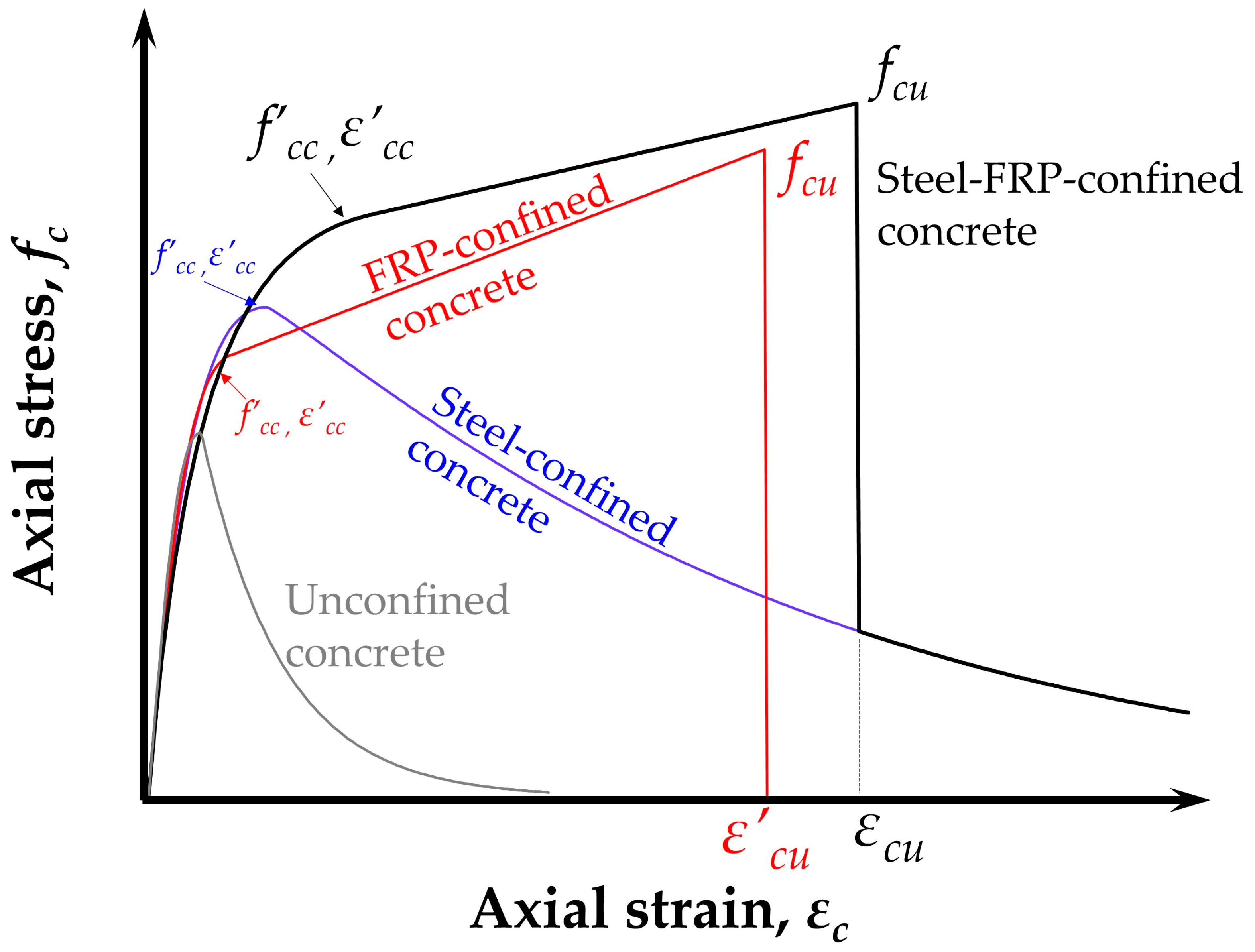

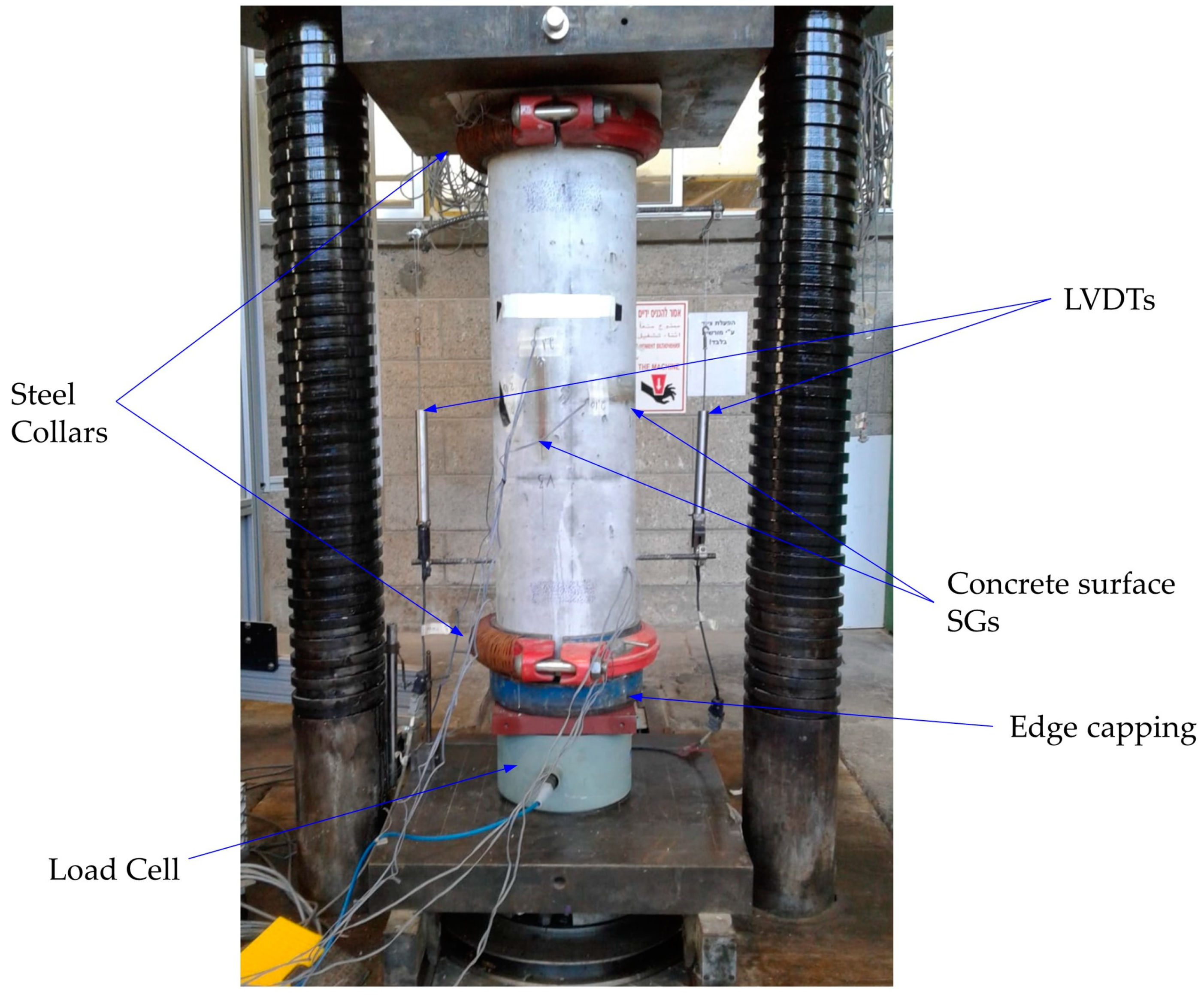
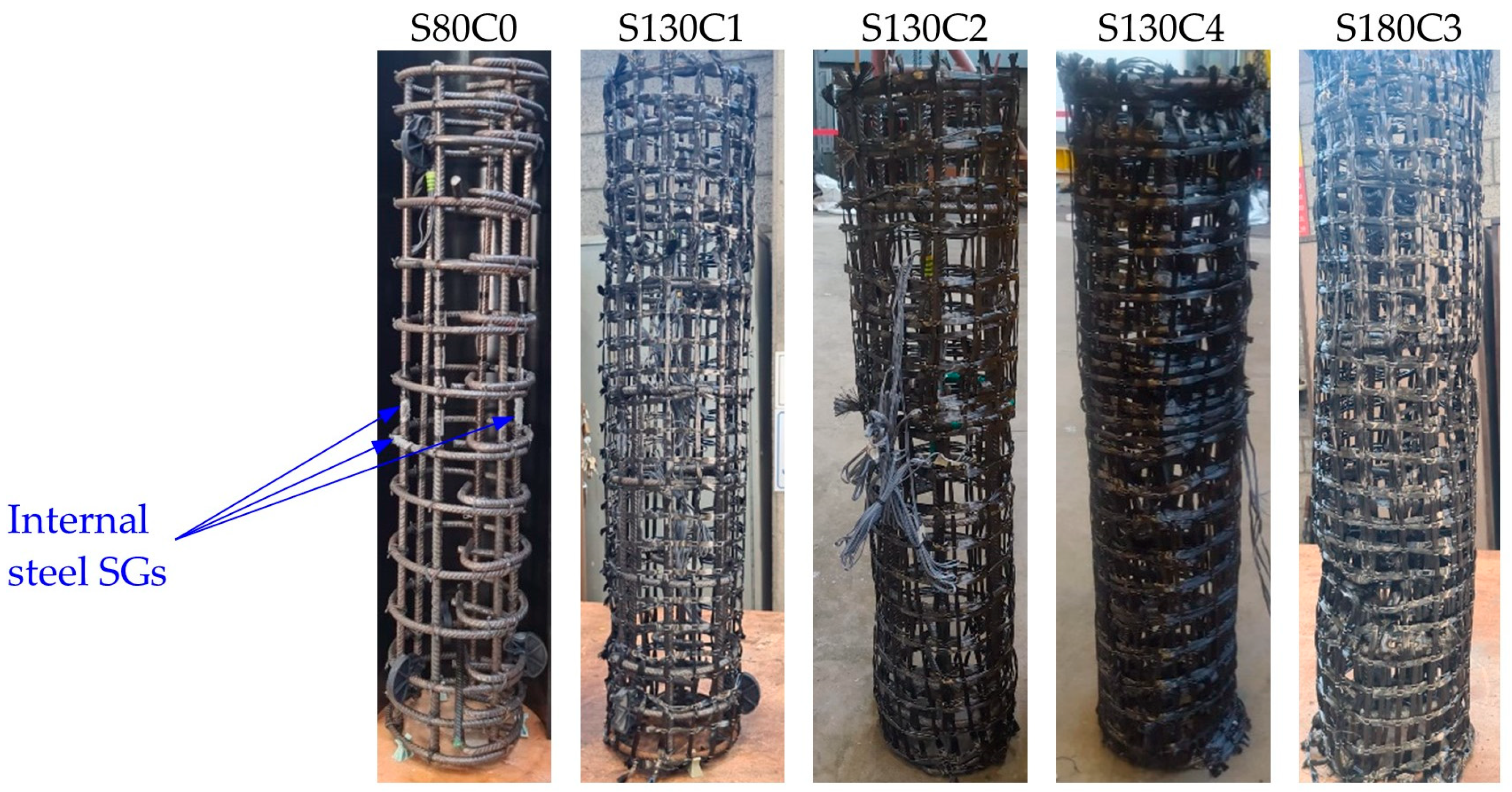

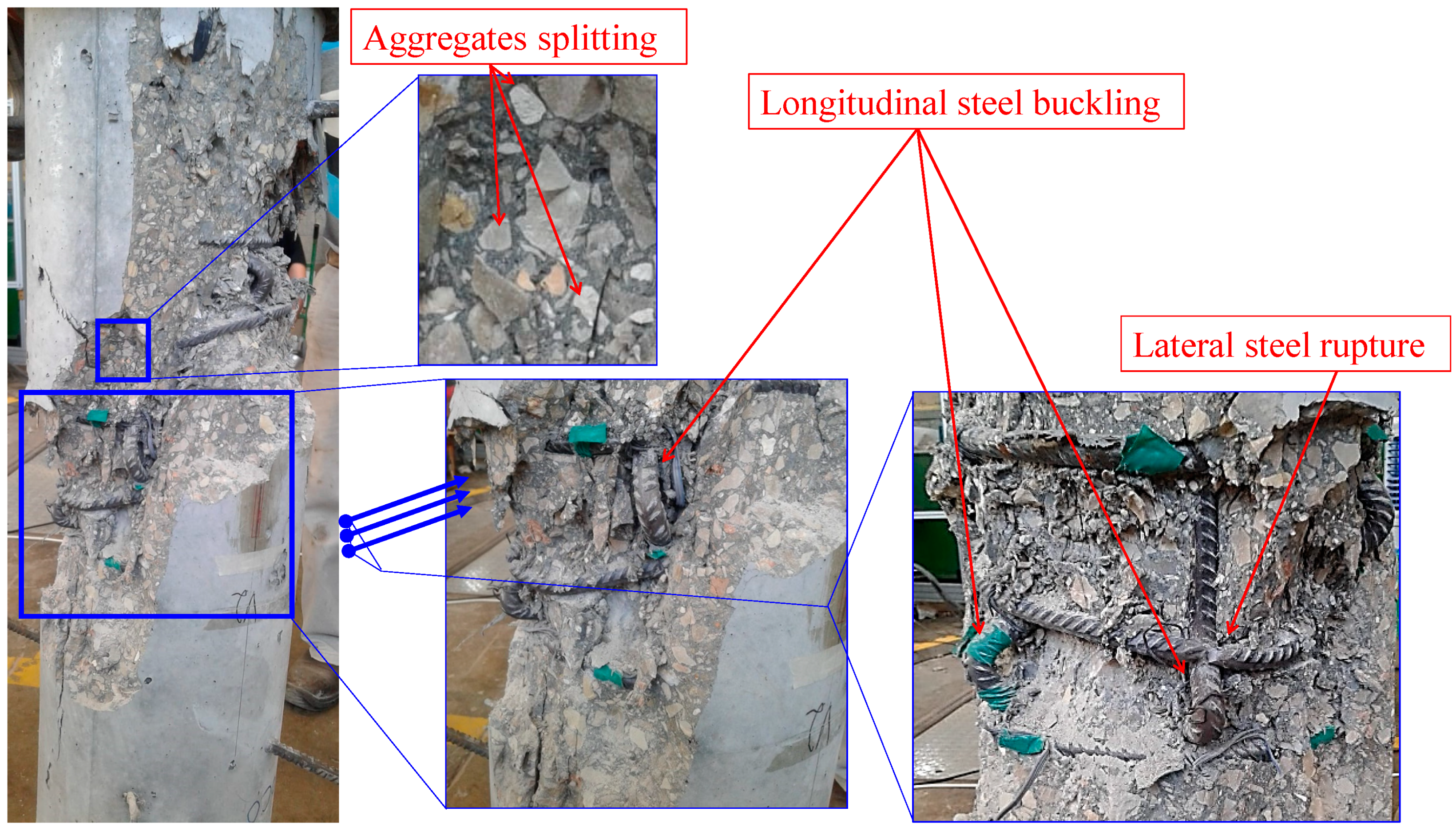

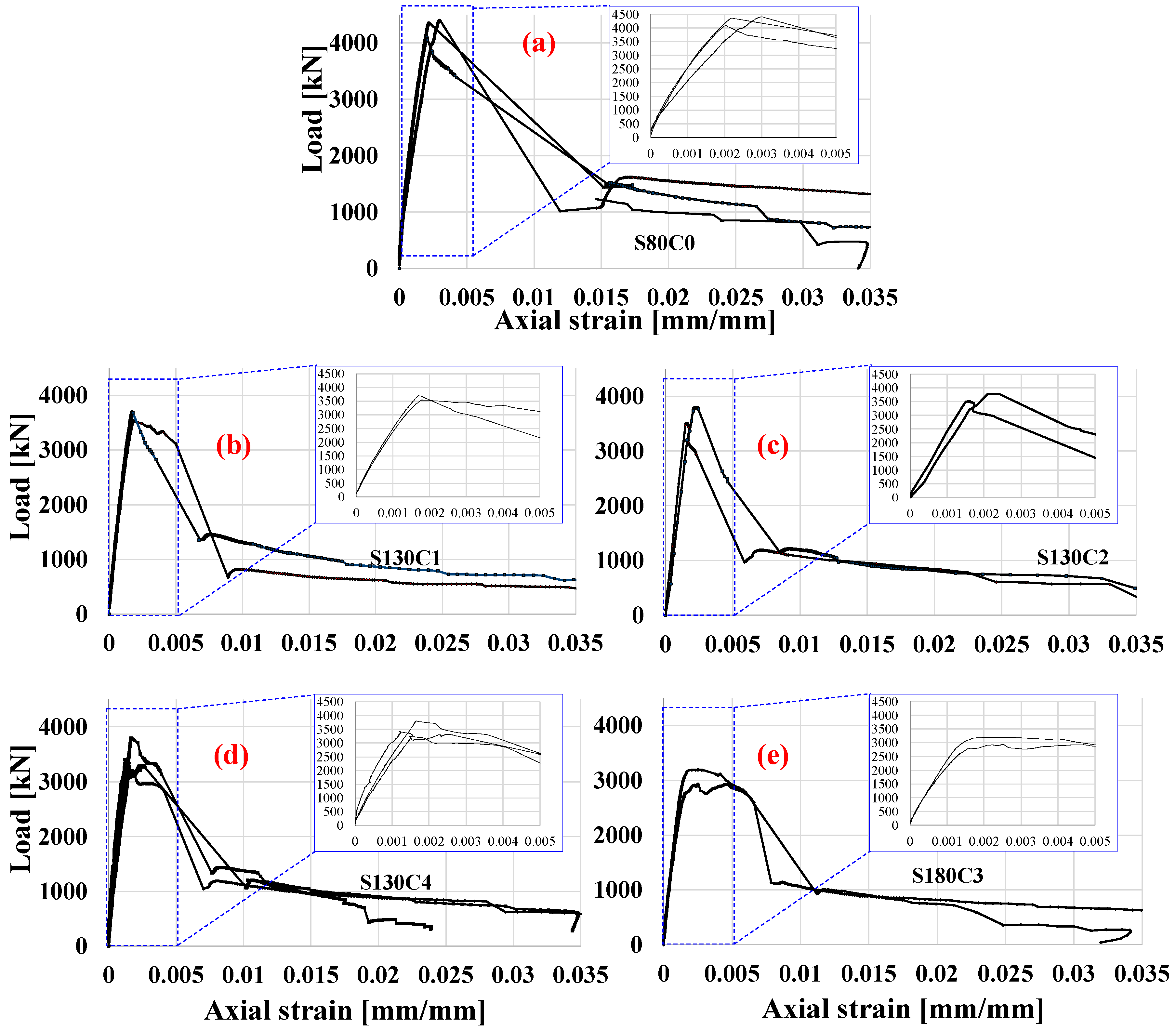
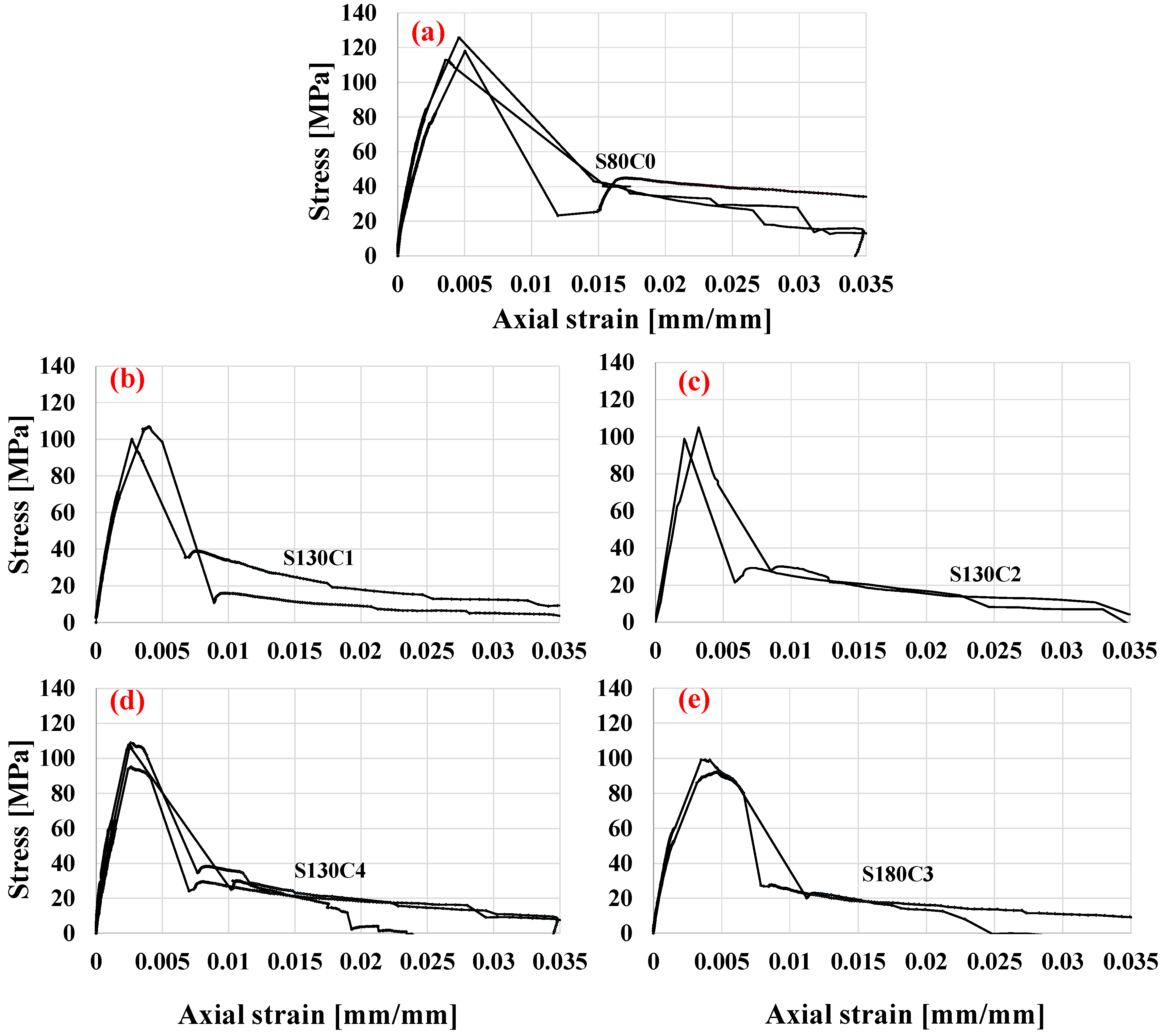


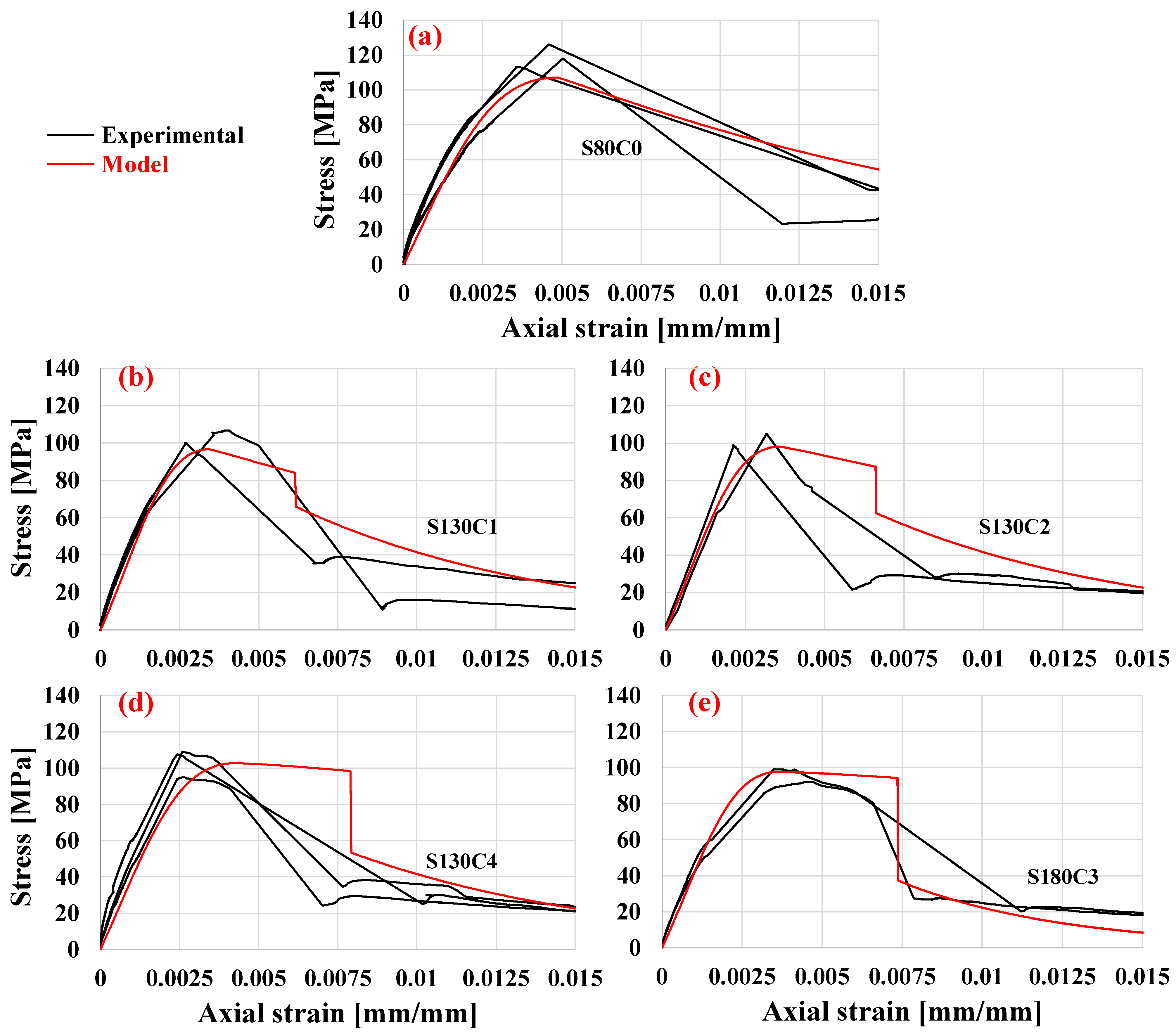


| Component | Amount |
|---|---|
| Portland cement CEM I-52.5N (kg/m3) | 492 |
| Water (kg/m3) | 118 |
| Fly ash (kg/m3) | 103 |
| Polypropylene fibers (kg/m3) | 2 |
| Coarse aggregate (kg/m3) | 677 |
| Sand (kg/m3) | 1041 |
| Superplasticizer SIKA3110 (kg/m3) | 10 |
| Retarding admixture BGR-80 (kg/m3) | 2 |
| Slump (mm) | 140 |
| Air content (%) | 2 |
| Water to cementitious materials—w/c | 0.24 |
| 28-day average 150 × 150 mm cube compressive strength (MPa) | 99.6 |
| Name | Transverse Steel Reinforcement | CFM | |||||||
|---|---|---|---|---|---|---|---|---|---|
| Φh (mm) | s (mm) | fhy (MPa) | ρs (%) | Sf(mm) | Aroving (mm2/m) | Layers | teq {1} (mm) | ||
| 1 | S80C0a | 10 | 80 | 582 | 1.78 | - | 0 | 0 | 0 |
| 2 | S80C0b | 10 | 80 | 582 | 1.78 | - | 0 | 0 | 0 |
| 3 | S80C0c | 10 | 80 | 582 | 1.78 | - | 0 | 0 | 0 |
| 4 | S130C1a | 10 | 130 | 582 | 1.10 | 38 | 95 | 1 | 0.095 |
| 5 | S130C1b | 10 | 130 | 582 | 1.10 | 38 | 95 | 1 | 0.095 |
| 6 | S130C2a | 10 | 130 | 582 | 1.10 | 51 | 71 | 2 | 0.142 |
| 7 | S130C2b | 10 | 130 | 582 | 1.10 | 51 | 71 | 2 | 0.142 |
| 8 | S130C4a | 10 | 130 | 582 | 1.10 | 51 | 71 | 4 | 0.284 |
| 9 | S130C4b | 10 | 130 | 582 | 1.10 | 51 | 71 | 4 | 0.284 |
| 10 | S130C4c | 10 | 130 | 582 | 1.10 | 51 | 71 | 4 | 0.284 |
| 11 | S180C3a | 10 | 180 | 582 | 0.79 | 38 | 95 | 3 | 0.285 |
| 12 | S180C3b | 10 | 180 | 582 | 0.79 | 38 | 95 | 3 | 0.285 |
| Transverse Steel Reinforcement | CFM Lateral Reinforcement | |||||
|---|---|---|---|---|---|---|
| Ties Spacing s (mm) | ρs (%) | teq = 0 mm | teq = 0.095 mm | teq = 0.285 mm | teq = 0.570 mm | |
| Normalized Ductility | ||||||
| 1 | 80 | 1.78 | 5.94 | 5.98 | 6.15 | 6.62 |
| 2 | 130 | 1.10 | 3.02 | 3.13 | 3.44 | 4.14 |
| 3 | 180 | 0.79 | 1.96 | 2.11 | 2.52 | 3.38 |
Disclaimer/Publisher’s Note: The statements, opinions and data contained in all publications are solely those of the individual author(s) and contributor(s) and not of MDPI and/or the editor(s). MDPI and/or the editor(s) disclaim responsibility for any injury to people or property resulting from any ideas, methods, instructions or products referred to in the content. |
© 2023 by the authors. Licensee MDPI, Basel, Switzerland. This article is an open access article distributed under the terms and conditions of the Creative Commons Attribution (CC BY) license (https://creativecommons.org/licenses/by/4.0/).
Share and Cite
Shachar, Y.M.; Eid, R.; Dancygier, A.N. Experimental and Analytical Study on the Axial Behavior of Circular High-Strength Concrete Columns with Hybrid Carbon Fibers and Steel Confinement System. Buildings 2023, 13, 2180. https://doi.org/10.3390/buildings13092180
Shachar YM, Eid R, Dancygier AN. Experimental and Analytical Study on the Axial Behavior of Circular High-Strength Concrete Columns with Hybrid Carbon Fibers and Steel Confinement System. Buildings. 2023; 13(9):2180. https://doi.org/10.3390/buildings13092180
Chicago/Turabian StyleShachar, Yedidya M., Rami Eid, and Avraham N. Dancygier. 2023. "Experimental and Analytical Study on the Axial Behavior of Circular High-Strength Concrete Columns with Hybrid Carbon Fibers and Steel Confinement System" Buildings 13, no. 9: 2180. https://doi.org/10.3390/buildings13092180






